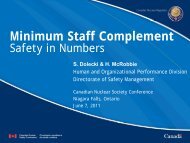Investigation of the Environmental Fate of Tritium in the Atmosphere
Investigation of the Environmental Fate of Tritium in the Atmosphere
Investigation of the Environmental Fate of Tritium in the Atmosphere
Create successful ePaper yourself
Turn your PDF publications into a flip-book with our unique Google optimized e-Paper software.
INVESTIGATION OF THE ENVIRONMENTAL FATE OF TRITIUM IN THE ATMOSPHERE<br />
<strong>Tritium</strong> is produced as a fission product <strong>in</strong> nuclear weapons tests and <strong>in</strong> nuclear power<br />
reactors, with a yield <strong>of</strong> approximately 0.01% (Albenesius, 1959; Albenesius and Ondrejc<strong>in</strong>,<br />
1960; ANL, 2005; Haney et al., 1962; Horrocks, 1964; Jacobs, 1968; Serot et al., 2005; Sloth<br />
et al., 1962; Watson, 1961; Wegner, 1961). This represents approximately one tritium atom<br />
per 10,000 fission events. A residual <strong>of</strong> approximately 0.7 to 5.0 kg <strong>of</strong> tritium per megatonequivalent<br />
explosion is generated from <strong>the</strong> fusion reaction <strong>of</strong> a deuterium-tritium bomb <strong>in</strong> a<br />
pure <strong>the</strong>rmonuclear detonation, with an additional yield <strong>of</strong> up to 0.15 kg <strong>of</strong> tritium through<br />
<strong>the</strong> neutron irradiation <strong>of</strong> nitrogen (as shown <strong>in</strong> Equation 2.1 above) (Eriksson, 1965;<br />
Leipunsky, 1960; Martell, 1959, 1963; Miskel, 1964).<br />
Total and fission tritium yields for each reported atmospheric test over <strong>the</strong> period between<br />
1945 and 1978 have been estimated (Bennett, 1978). Data compiled over this period<br />
<strong>in</strong>cluded tritium releases from 422 nuclear tests <strong>in</strong> <strong>the</strong> atmosphere, with cumulative yields <strong>of</strong><br />
217 megatons and 328 megatons for fission and fusion, respectively. This corresponded to<br />
estimated yields <strong>of</strong> 2.6 x 10 13 Bq tritium per megaton for fission explosions and 7.4 x 10 17 Bq<br />
tritium per megaton for fusion, and a total tritium activity <strong>of</strong> 2.4 x 10 20 Bq tritium for<br />
atmospheric tests (based on tritium generated from fusion reactions) (Miskel, 1973).<br />
The tritium that is produced by a nuclear explosion is almost completely converted to<br />
tritiated water (HTO), which <strong>the</strong>n mixes with environmental water, as described by <strong>the</strong><br />
follow<strong>in</strong>g equation (UN, ILO and WHO, 1983):<br />
HT + H 2O<br />
HTO + H 2<br />
Equation 2.2<br />
Most <strong>of</strong> <strong>the</strong> bomb tritium, which has been oxidized to form water, is removed from <strong>the</strong><br />
troposphere by precipitation, although <strong>the</strong> tritium-to-hydrogen ratio for atmospheric<br />
hydrogen gas and methane is much higher (Jacobs, 1968; Martell, 1959). As a result, past<br />
<strong>the</strong>rmonuclear detonations have led to sharp <strong>in</strong>creases <strong>in</strong> tritium levels <strong>of</strong> up to several orders<br />
<strong>of</strong> magnitude greater than natural levels <strong>in</strong> ra<strong>in</strong>, with temporary <strong>in</strong>creases <strong>in</strong> tritium <strong>of</strong> 1000fold<br />
<strong>in</strong> precipitation <strong>in</strong> <strong>the</strong> nor<strong>the</strong>rn hemisphere follow<strong>in</strong>g weapons test<strong>in</strong>g <strong>in</strong> <strong>the</strong> early 1960s<br />
(e.g., Begemann and Libby, 1957; von Buttlar and Libby, 1955). S<strong>in</strong>ce 1963, <strong>the</strong> temporary<br />
extremes <strong>in</strong> <strong>the</strong> tritium content have decreased to essentially natural values <strong>in</strong> <strong>the</strong> w<strong>in</strong>ter and<br />
values that are approximately twice natural levels <strong>in</strong> <strong>the</strong> summer.<br />
Based on measurements <strong>of</strong> tritium <strong>in</strong> precipitation taken at stations <strong>in</strong> <strong>the</strong> IAEA network,<br />
a total tritium production <strong>of</strong> 1.7 x 10 20 Bq from weapons test<strong>in</strong>g has been estimated (Schell<br />
et al., 1974). Similar weapons tritium estimates, rang<strong>in</strong>g from 1.2 x 10 20 Bq (<strong>in</strong> oceans only)<br />
to 2.4 x 10 20 Bq, have been made us<strong>in</strong>g measurements <strong>of</strong> tritium taken <strong>in</strong> vertical pr<strong>of</strong>iles <strong>in</strong><br />
<strong>the</strong> oceans (Bowen and Roe<strong>the</strong>r, 1973; Mitchel, 1976; Ostlund and F<strong>in</strong>e, 1979; UNSCEAR,<br />
1977). On <strong>the</strong> basis <strong>of</strong> <strong>the</strong>se estimates, UNSCEAR (1977) adopted a value <strong>of</strong> 1.7 x 10 20 Bq<br />
tritium to represent <strong>the</strong> amount <strong>of</strong> tritium that was dispersed globally due to atmospheric<br />
weapons test<strong>in</strong>g up to 1976.<br />
BACK TO TABLE OF CONTENTS 8



